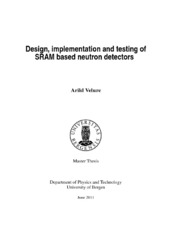| dc.description.abstract | Neutrons of thermal and high energies can change the value of a bit stored in a Static Random Access Memory (SRAM) memory chip. The effect is non destructive and linearly dependent on the amount of incoming particles, which makes it exploitable for use as a neutron detector. Detection is done by writing a known pattern to the memory and continuously reading it back checking for wrong values. As the SRAM memory is immune to gamma radiation it is ideal for use in for instance medical linear accelerators for detection of neutron dose to a patient. The intention of this work has been twofold: (1) Testing of different SRAM devices of different bit-sizes, manufacturers, feature sizes and voltages for their sensitivity to neutrons of different energies from thermal to high energies. (2) Design and implement detector hardware, firmware and its accompanying readout system for successful use in irradiation testing. The work has been done in close collaboration with Eivind Larsen, whose main contributions has been related to the nuclear physics aspect of the work in addition to arrangements in regard to beam setup and experimentation. Testing have been done at the Physikalisch-Technische Bundesanstalt (PTB) facility in Braunschweig Germany in a quasi-monochromatic neutron beam of 5:8MeV, 8:5MeV and 14:8MeV, finding a dependence of the sensitivity on the energy. In addition there have been testing conducted in the high energy hadron field at CERF at CERN, finding that by using the results from the other experiments an estimated range of the saturation cross section could be determined. Testing was also conducted at two occasions in the 29MeV proton beam at Oslo Cyclotron Laboratory (OCL) in Oslo Norway, where it was found that the detector could be used as a reference detector for beam monitoring and for beam profile characterization. The cross sections of the detectors were found to be comparable to the 14:8MeV cross section found at PTB. Thermal neutron testing of the devices was done in the thermal neutron field of the nuclear reactor at Institute for Energy Technology (IFE) at Kjeller Norway. All the devices were found to be sensitive to the field. Detector electronics, adapted to the different devices, has been built which can withstand the same radiation as the memory device without malfunctioning. There has been a focus on using Commercial Off The Shelf (COTS) components for reducing the total cost of the detector to about 100-200$US. The use of COTS SRAM memory devices also simplifies the reproducibility and availability of spares. The detector currently uses a two way communication between the detector and iv Abstract the readout computer over two pair of cables reducing the amount of cabling needed for experiments. The detectors can be connected to the communication link in a bus fashion, currently enabling a total of 14 detectors to be tested simultaneously from 100m away, over the same cable. Single Event Latch-up (SEL) and problems with irregular count rate of SRAMs created in the 90nm fabrication node has created problems during testing. Some solutions and techniques to mitigate these in hardware and firmware are presented in this work. | en_US |
